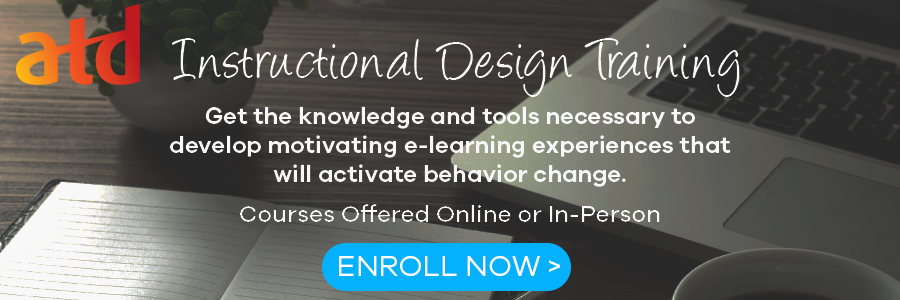Blog
10 Mobile Learning Terms that Every Instructional Designer Should Know
By Guest Blogger Christopher Pappas / @cpappas


7 Best Practices to Create e-Learning Courses For Digital Immigrants
By Christopher Pappas | August 31, 2016 | Custom Learning | 0 Comments
By Guest Blogger Christopher Pappas / @cpappas
 Not everyone is savvy with a smartphone. In fact, there are some members of your audience who still prefer pen and paper over a tablet. These are your "digital immigrants" and they may be a bit hesitant about using tech to expand their knowledge. In this article, I'll share the 7 best practices for creating e-learning courses for digital immigrants.
Not everyone is savvy with a smartphone. In fact, there are some members of your audience who still prefer pen and paper over a tablet. These are your "digital immigrants" and they may be a bit hesitant about using tech to expand their knowledge. In this article, I'll share the 7 best practices for creating e-learning courses for digital immigrants.
How To Create e-Learning Courses For Digital Immigrants
 Digital immigrants didn't grow up with the technology that we know and love today. In fact, many of them didn't encounter a mobile device until they reached adulthood. This is in stark contrast to digital natives, who were born into a world where tablets, smartphones, and wearable tech are commonplace. Thanks to the growing popularity of e-learning, digital immigrants are now venturing into the world of online education. They may not be as eager or prepared for the virtual classroom experience, but there are ways to ease them into tech-centric e-learning courses without alienating the rest of your audience.
Digital immigrants didn't grow up with the technology that we know and love today. In fact, many of them didn't encounter a mobile device until they reached adulthood. This is in stark contrast to digital natives, who were born into a world where tablets, smartphones, and wearable tech are commonplace. Thanks to the growing popularity of e-learning, digital immigrants are now venturing into the world of online education. They may not be as eager or prepared for the virtual classroom experience, but there are ways to ease them into tech-centric e-learning courses without alienating the rest of your audience.
1. Measure their tech-savviness beforehand.
The secret to developing e-learning courses for digital immigrants is finding out how long they've been using technology and their level of familiarity. For example, some digital immigrants wouldn't dream of leaving the house without their trusty smartphones, while others are still unsure about how to check their email. Conduct surveys, questionnaires, diagnostic assessments, and focus groups to measure their tech-savviness before you start the e-learning design process. You might think you have a clear idea of how much they know, but audience research may contradict your assumptions.
2. Take a microlearning approach.
Microlearning content is bite-sized and convenient. Digital immigrants can get the information they need quickly, instead of having to participate in a lengthy e-learning course. This is beneficial for two key reasons: Firstly, it eases them into the e-learning process. They have the power to pick-and-choose which e-learning activities they'll access, which means that they can wade in the tech waters rather than jumping in headfirst. Secondly, digital immigrants have the opportunity to learn when it suits their personal schedule. They can set aside some time when there are minimal distractions, so that they are able to focus on one task at hand.
3. Opt for visuals over text-heavy e-learning courses.
This rule applies to all learner groups, but it's particularly useful for digital immigrants. These individuals may already be wary about navigating the e-learning course platform and interacting with mobile learning. As a result, they usually prefer visuals over text, such as graphics, images, and charts. Infographics are also ideal, as they deliver all of the essential information in a more visual format and require minimal e-learning course navigation. All of the data they need is all on one page, so they don't have to worry about ambiguous icons or lengthy text blocks.
4. Foster a supportive e-learning environment.
Many digital immigrants feel alienated by the fact that they aren't tech gurus. Generation Y and Z grew up with tech, but the same cannot be said for Baby Boomers. For this reason, you have to cultivate a supportive e-learning environment and culture that offers them help every step of the way. They need to feel as though they are part of something bigger—an online learning community that can give them the tools and knowledge they need to take advantage of technology. Pair them with mentors who can show them the ropes and both parties will benefit. Provide them as well with a list of supplemental online resources that they can access on their own time. For example, e-learning videos, websites, and tutorials that discuss different aspects of technology.
5. Use social media to bridge the gap.
![]() Social networking sites, such as LinkedIn, Twitter, Facebook, and YouTube are an invaluable e-learning tool. Digital immigrants and digital natives alike can share their feedback, ask questions, and collaborate on e-learning projects from anywhere in the world. If your online learners are hesitant about using social media, consider creating an online page for your e-learning course and invite them to post comments and offer their insight. Pose thought-provoking questions and share links that they may find helpful.
Social networking sites, such as LinkedIn, Twitter, Facebook, and YouTube are an invaluable e-learning tool. Digital immigrants and digital natives alike can share their feedback, ask questions, and collaborate on e-learning projects from anywhere in the world. If your online learners are hesitant about using social media, consider creating an online page for your e-learning course and invite them to post comments and offer their insight. Pose thought-provoking questions and share links that they may find helpful.
6. Always explain the WHY behind the WHAT.
Digital immigrants are adult learners, and adult learners need to know the purpose behind every e-learning activity. You have to explain why they must learn the information, what role technology will play, and how they will benefit from the e-learning course. There has to be a goal that they can set their sights on and a motive behind that goal. At the beginning of the e-learning program you should emphasize the real world applications and benefits, as well as expectations. Be clear about how technology will be used and which Learning Management System you're focusing on. For example, will they be using social media on a regular basis? Will branching scenarios be part of the e-learning curriculum? If so, why have you chosen these specific e-learning activities?
7. Integrate tech e-learning activities that gradually expand their comfort zone.
Certain members of your audience may be completely out of their element, particularly those who aren't comfortable with tech-based e-learning. As such, it's wise to slowly but surely integrate tech related online activities into your e-learning course design. For example, the first module may be low-tech, while the second module introduces a multimedia presentation. All of this leads up to highly interactive simulations, online scenarios, and serious games.
It’s important to research your audience in advance to gauge their level of tech experience. Many digital immigrants are ready and willing to embrace technology, especially if they know that it can benefit their personal and professional lives. Others may be more resistant to the e-learning process. Whatever the case is, you can custom tailor your e-learning strategy to meet their needs by identifying their preferences, skills, and current knowledge base.
Did you know that baby boomers make up a good percentage of the digital immigrant population? Read the article 8 Important Characteristics Of Baby Boomers eLearning Professionals Should Know to discover the key characteristics of this generation that every e-learning professional should consider.
SHARE THIS BLOG WITH THE READY-MADE TWEET BELOW!
 CLICK HERE TO TWEET: 7 #BestPractices To Create #eLearning Courses For Digital Immigrants http://hubs.ly/H0488rN0 #aiblog
CLICK HERE TO TWEET: 7 #BestPractices To Create #eLearning Courses For Digital Immigrants http://hubs.ly/H0488rN0 #aiblog

About the Author: Christopher Pappas
Comments
Would you like to leave a comment?
Related Blog Posts

By: Christopher Pappas | Apr, 2016
Category: Custom Learning

Blog
The Structure Of Intellect: Everything e-Learning Pros Need To Know
By Guest Blogger Christopher Pappas / @cpappas
By: Christopher Pappas | Oct, 2016
Category: Custom Learning, Strategic Consulting
.png?width=316&name=2023%20Blog%20Covers%20and%20In-Line%20Graphics%20(38).png)
Blog
Talking SAM, CCAF, And Adaptive Learning With Dr. Michael Allen
By Guest Blogger Christopher Pappas / @cpappas
By: Christopher Pappas | May, 2023
Category: Custom Learning, Dr. Michael Allen

